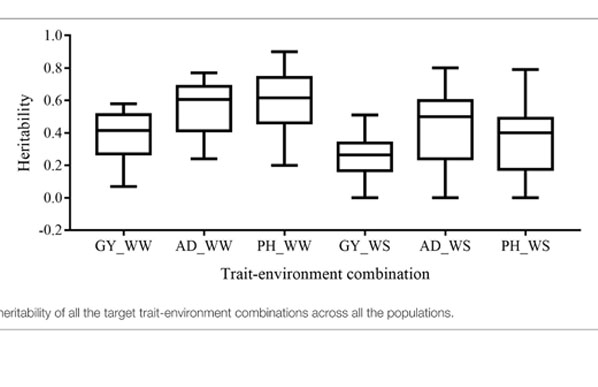Effect of Trait Heritability, Training Population Size and Marker Density on Genomic Prediction Accuracy Estimation in 22 bi-parental Tropical Maize Populations
作 者:Ao Zhang, Hongwu Wang, Yoseph Beyene, Kassa Semagn, Yubo Liu, Shiliang Cao, Zhenhai Cui, Yanye Ruan, Juan Burgueño, Felix San Vicente, Michael Olsen, Boddupalli M. Prasanna, José Crossa, Haiqiu Yu, and Xuecai Zhang
影响因子:4.298
刊物名称:Frontiers in plant science
出版年份:2017
卷:8 期:08 November 页码:1916
doi:10.3389/fpls.2017.01916
文章摘要:
Genomic selection is being used increasingly in plant breeding to accelerate genetic gain per unit time. One of the most important applications of genomic selection in maize breeding is to predict and select the best un-phenotyped lines in bi-parental populations based on genomic estimated breeding values. In the present study, 22 bi-parental tropical maize populations genotyped with low density SNPs were used to evaluate the genomic prediction accuracy (rMG) of the six trait-environment combinations under various levels of training population size (TPS) and marker density (MD), and assess the effect of trait heritability (h2), TPS and MD on rMG estimation. Our results showed that: (1) moderate rMG values were obtained for different trait-environment combinations, when 50% of the total genotypes was used as training population and ~200 SNPs were used for prediction; (2) rMG increased with an increase in h2, TPS and MD, both correlation and variance analyses showed that h2 is the most important factor and MD is the least important factor on rMG estimation for most of the trait-environment combinations; (3) predictions between pairwise half-sib populations showed that the rMG values for all the six trait-environment combinations were centered around zero, 49% predictions had rMG values above zero; (4) the trend observed in rMG differed with the trend observed in rMG/h, and h is the square root of heritability of the predicted trait, it indicated that both rMG and rMG/h values should be presented in GS study to show the accuracy of genomic selection and the relative accuracy of genomic selection compared with phenotypic selection, respectively. This study provides useful information to maize breeders to design genomic selection workflow in their breeding programs.
下载链接:http://www.frontiersin.org/articles/10.3389/fpls.2017.01916/full





